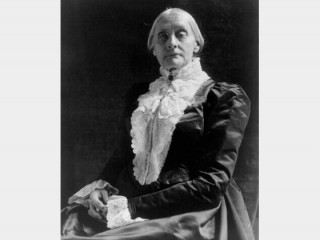
Susan Brownell Anthony biography
Date of birth : 1820-02-15
Date of death : 1906-03-13
Birthplace : Adams, Massachusetts, U.S.
Nationality : American
Category : Famous Figures
Last modified : 2010-07-16
Credited as : Activist and abolitionist, leader of woman's suffrage,
0 votes so far
Susan Brownell Anthony was an early leader of the American woman's suffrage movement and pioneered in seeking other equalities for women. An active abolitionist, she campaigned for emancipation of the slaves.
Susan B. Anthony was born on February 15, 1820, in Adams, Massachusetts, one of seven children. Her family had settled in Rhode Island in 1634. She attended Quaker schools and began teaching at the age of 15 for $1.50 a week plus board. When the family moved to Rochester, New York, in 1845, her brilliant father, Daniel Anthony, the dominant influence in her life, worked with important abolitionists. Frederick Douglass, William Lloyd Garrison, Wendell Phillips, and other guests at the Anthony farm helped form her strong views on the abolition of slavery.
Though her family attended the first Woman's Rights Convention held in Seneca Falls and Rochester, New York, in 1848, Anthony did not take up the cause of woman's rights until 1851, when male hostility to her temperance efforts convinced her that women must win the right to speak in public and to vote before anything else could be accomplished. Her lifelong friendship and partnership with Elizabeth Cady Stanton also began in 1851, as did her temporary doffing of corsets in favor of the revolutionary "bloomer" costume--which was women's first major dress reform in the movement. Anthony attended her first woman's-rights convention in 1852; from then until the end of the Civil War she campaigned from door to door, in legislatures, and in meetings for the two causes of abolition of slavery and of woman's rights. The New York State Married Woman's Property and Guardianship Law in 1860 was her first major legislative victory.
With the outbreak of the Civil War in 1861, woman's rights took second place. Anthony organized the Women's National Loyal League, which mobilized the crucial petitions to force passage of the Thirteenth Amendment to the Constitution to abolish slavery. In 1865 she began her battle in the content of the Fourteenth and Fifteenth Amendments, hoping to gain the franchise for women as well as for African American males. But her former male allies in the abolitionist struggle brushed her aside, saying the time was not yet ripe for woman's suffrage. Saddened but not deterred by this defeat, Anthony worked solely for woman's suffrage from this time to the end of her life, organizing the National Woman Suffrage Association with Stanton. The association's New York weekly The Revolution was created in 1868 to promote women's causes. After its bankruptcy in 1870, Anthony lectured throughout the nation for six years to pay its $10,000 debt.
In the 1872 presidential race Susan Anthony and 15 Rochester comrades became the first women ever to vote in a national election. That they were promptly arrested for their boldness did not dismay her, as she sought to test women's legal right to vote under the Fourteenth Amendment by carrying the case to the U.S. Supreme Court. Her case was singled out for prosecution, and trial was set for 1873 in Rochester. Free on bail of $1,000, Anthony stumped the country with a carefully prepared legal argument, "Is It a Crime for a U.S. Citizen to Vote?" She lost her case, following some dubious legal maneuvering by the judge, but was unfortunately barred from appealing to the Supreme Court when her sentence was not made binding.
Susan Anthony spent the rest of her life working for the federal suffrage amendment--a strenuous effort that took her not only to Congress but to political conventions, labor meetings, and lyceums in every section of the country. Mindful of the nearly total omission of women from historical literature, in 1877 she forced herself to sit down with her colleagues to begin the monumental and invaluable History of Woman Suffrage in five volumes. She later worked with her biographer, Ida Husted Harper, on two of the three volumes of The Life and Work of Susan B. Anthony, which were drawn largely from her continuous scrapbooks (1838-1900), now in the Library of Congress, and her diaries and letters.
Up to just one month before her death in 1906, Anthony was still active: she attended her last suffrage convention and her eighty-sixth birthday celebration in Washington. She closed her last public speech with the words, "Failure is impossible." When she died in her Rochester home on March 13, only four states had granted the vote to women. Fourteen years later the suffrage amendment, the nineteenth, was added to the Constitution.
















